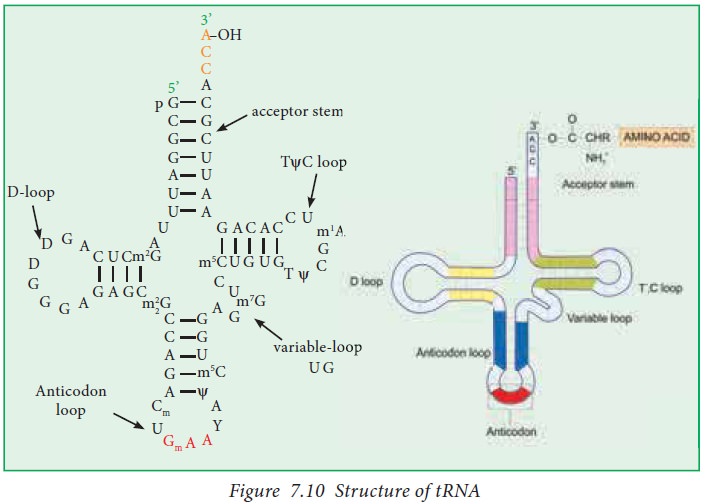Chapter: 11th Biochemistry : Chapter 7 : Nucleic Acids
Types of Ribonucleic acids (RNA)
Ribonucleic acids (RNA)
RNAs, the second most abundant form
of nucleic acids inside the cell are single-stranded and composed of
nucleotides with ribose as their sugar. The major role of RNA is in protein
synthesis as it aids in transfer of information from nucleus to cytosol,
decoding, and synthesis of proteins. RNA nucleotides contain three components.
·
Nitrogenous Base
·
Ribose Sugar
·
Phosphate Group
The nitrogenous bases include adenine
(A), guanine (G), cytosine (C) and uracil (U).
Eventhough RNA is single-stranded, it
has the ability to form three-dimensional structures like hairpin loops by base
pairing within the strand. Adenine pairs with uracil (A=U) and guanine pairs
with cytosine (G‡C). Chargaff ’s rule is not followed by RNA.
Types of RNA
There are three major types of RNAs
in all prokaryotic and eukaryotic cells. They are (1). Messenger RNA (mRNA).
(2). Transfer RNA (tRNA) (3). Ribosomal RNA (rRNA). They differ from each other
by size, shape, formation and stability.
i. Messenger RNA
They are
named so because they carry the information from nucleus to cytosol. It
accounts for 1-5% of cellular RNA. They do not have specific secondary
structure like helices. They are single stranded linear molecules. They consist
of 1000-10,000 nucleotides. They have a free or phosphorylated 3΄and 5΄end.
They have different life span ranging from few minutes to days.
Prokaryotic
mRNA is different from eukaryotic mRNA. Prokaryotic mRNAs are polycistronic,
that is they code for many proteins. While eukaryotic mRNAs are monocistronic
and contain exons (expressed sequences) and introns (intervening sequences).
Eukaryotic mRNAs are capped at 5΄end by methylated guanosine triphosphate.
Capping protects mRNA from nuclease attack. At 3΄end, a polymer of adenylate
(polyA) is found as tail. Poly A tail protects mRNA from nuclease attack.
Intrastrand base pairing among
complementary bases allows folding of the linear molecule. As a result, haripin
or loop like secondary structure is formed.
Functions
o mRNA is a direct carrier of genetic information
from the nucleus to cytoplasm.
o It contains information required for the synthesis
of protein molecules.
ii. Transfer RNA
It
accounts for 10-15% of total cell RNA. Usually they consist of 50-100
nucleotides. They are single stranded molecules.They contain unusual bases such
as methylated adenine, thymine, dihydrouracil and pseudouridine. These unusual
bases are unique to tRNA. Intra-chain base pairing is observed with many base
pairs, while some bases are not involved in base pairing, resulting in loops
and arms formation in tRNA. These foldings in the primary structure generates a
clover-leaf secondary structure (Figure 7.10).

The important features of the
clover-leaf structure are,
·
An acceptor arm with base sequence “CCA” is present at the 3΄end. The
hydroxyl group of adenosine moiety of tRNA is responsible for getting amino
acylated.
·
An anticodon arm which recognises codon on mRNA is present.
·
A TψC loop which contain an unusual base pseudouracil.
·
A D - arm which contain many dihydrouracil residues.
Functions
·
It is the carrier
of amino acids to the site of protein synthesis.
·
There is at least
one t-RNA molecule to each of 20 amino acids required for protein synthesis.
iii. Ribosomal RNA
Ribosomal RNA accounts for 80% of the
total cellular RNA. It is present in ribosomes in combination with proteins. It
is known as ribonucleoprotein. The length of rRNA ranges from100-600
nucleotides. rRNA molecules have a secondary structure. Intra-strand base
pairing between complementary bases often generate double helical segments or
loops.
Functions
·
They are required
for the formation of ribosomes.
· They are involved in the initiation of protein synthesis.
Related Topics